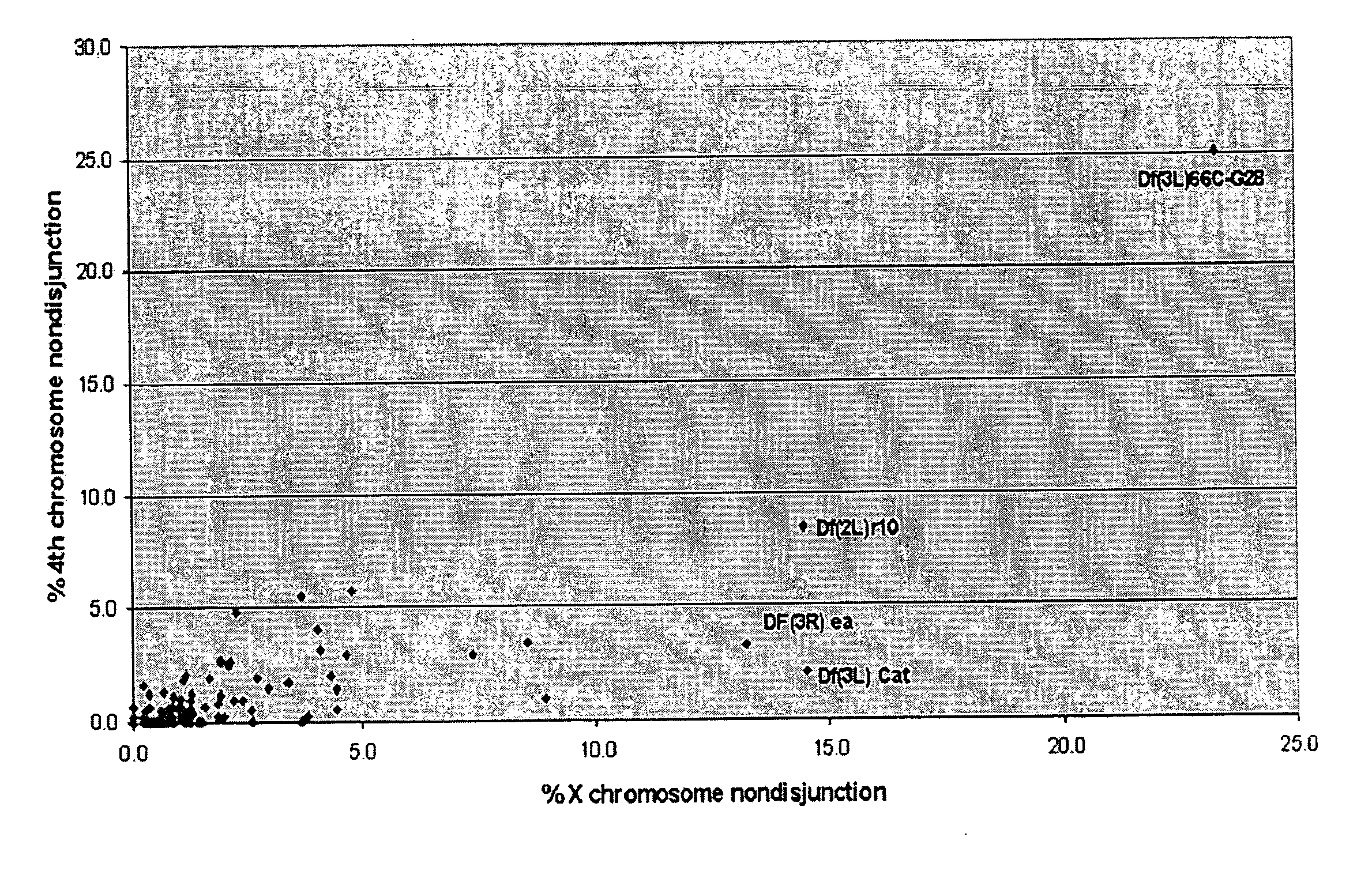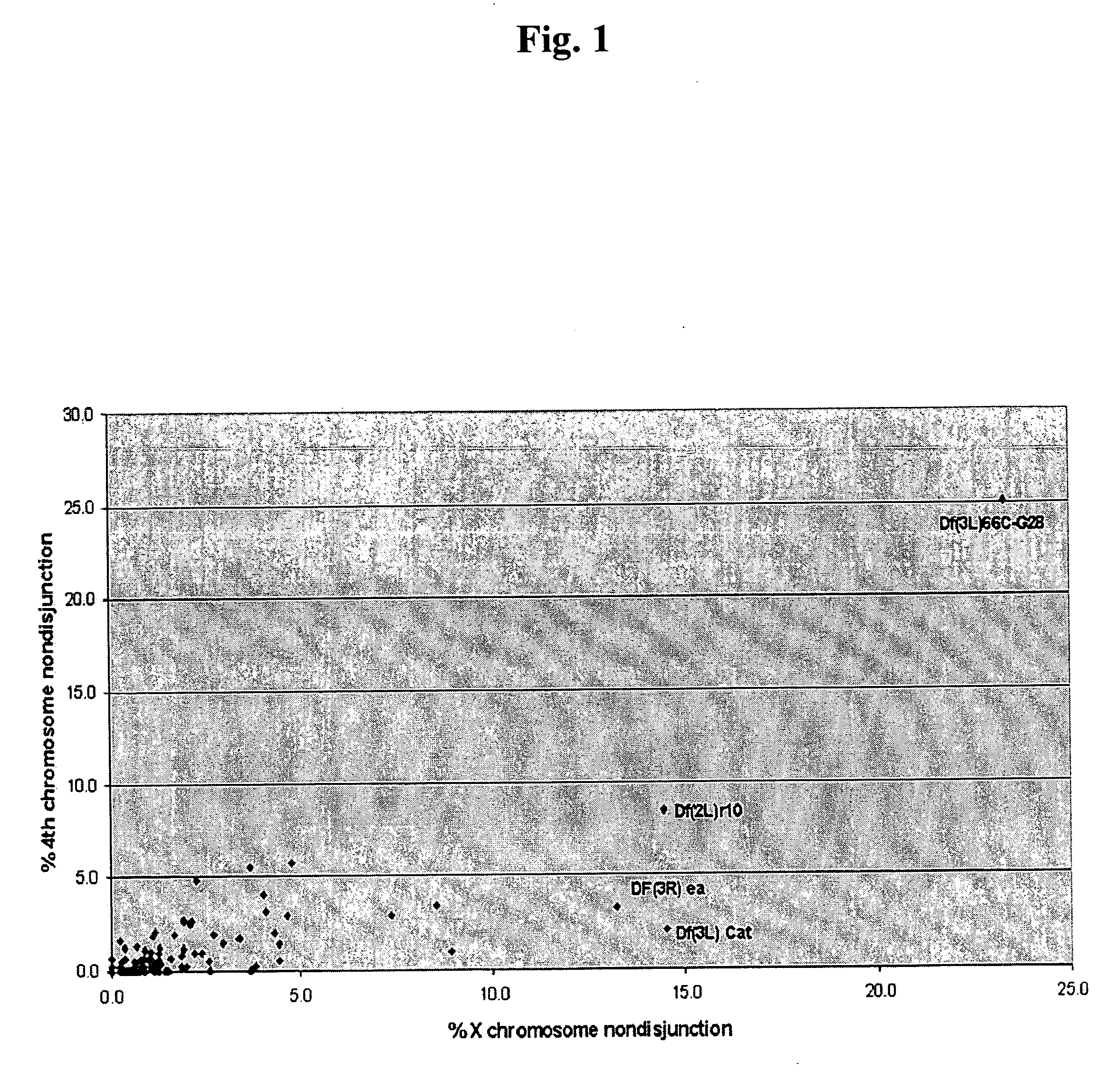Matrimony gene and protein
a technology of matrix and gene, applied in the field of matrix (mtrm) nucleotide sequence, can solve the problem of haplo-insufficient chromosome having a mutant mtrm sequen
- Summary
- Abstract
- Description
- Claims
- Application Information
AI Technical Summary
Benefits of technology
Problems solved by technology
Method used
Image
Examples
example 1
[0097] As will be shown, a protein was identified that is required in normal dosage for hetrochromatic associations to assure the proper segregation of achiasmate chromosomes, the protein was named matrimony (Mtrm). The method of identification was initiated based on the assumption that a reduction in the quantity of some essential ‘glue’ or ‘binder’ protein by 50% might have dramatic and direct effects on achiasmate segregation. A deficiency heterozygote was used, whereby one allele was wt, and the other was a nonfunctional mutant. Resultantly, the expression of a lesser amount of functional protein occurred because one allele expressed a mutant protein.
[0098] To start, a Bloomington “deficiency kit” was screened for deficiencies that exhibited a dominant effect on X or 4th chromosomal nondisjunction in females of the genotype FM7 / X; Df / +; spapol (chromosomal balancer 7, X chromosome, deficiency heterozygous, recessive mutation spa allele pol). Genotype abbreviations will be used ...
example 2
[0103] As shown in FIG. 2, the limits of the haplo-insufficient region were established by five deficiencies that both overlapped Df(3L)66C-G28 and also exhibited a dominant defect in the achiasmate chromosome. Df(3L)66C-G28 reached all (or most) of region 66C. The mapping of the breakpoints of these deficiencies on the physical map of the Drosophila genome restricted the putative haplo-insufficient meiotic gene to a small interval within 66C (i.e. the distal and proximal limits of the haplo-insufficient region lie at positions 8,350,000 and 8,372,000, respectively, on the Release 3.1 sequence).
[0104] Five deficiencies located with Df(3L)66C-G28 were further examined. The effects of Df(3L)66C-G28 were phenocopied by some, but not all, overlapping deficiencies. The cytological breakpoints of Df(3L)66C-G28 were 66B8-9 and 66C9-10. As shown in Table 2, three overlapping and / or adjacent deficiencies, Df(3L)pbl-X1, Df(3L)ZPI, and Df(3L)h-i22 did not show meiotic defects and, thus, restr...
example 3
[0108] Next, the deficiency breakpoints were characterized. In order to determine the limits of the region that included the putative dosage-sensitive meiotic gene, the position of the ends of the deficiencies were portrayed in FIG. 3 on the physical map of the fly genome. This was accomplished by PCR analysis of homozygous deficiency-bearing oocytes using pairs of primers selected to define specific intervals in the proximal region of 66C. For Df(3L)66C-165, Df(3L)B2-2, and Df(3L)E3-1, the distal breakpoints were proximal to CG7176 (isocitrate dehydrogenase) and were distal to CG1116 (ImpE1). For Df(3L)T2-10, the distal breakpoint was immediate proximal to CG1116 (ImpE1). Thus, the distal limit of the region containing the haplo-insufficient gene was approximated to between 8,310,000 and 8,312,000 on the Flybase map.
[0109] For Df(3L)T2-10, the proximal breakpoints were immediately distal to or within CG7015, which is consistent with the failure of these deficiencies to complement ...
PUM
| Property | Measurement | Unit |
|---|---|---|
| Fraction | aaaaa | aaaaa |
| Fraction | aaaaa | aaaaa |
| Fraction | aaaaa | aaaaa |
Abstract
Description
Claims
Application Information
 Login to View More
Login to View More - R&D
- Intellectual Property
- Life Sciences
- Materials
- Tech Scout
- Unparalleled Data Quality
- Higher Quality Content
- 60% Fewer Hallucinations
Browse by: Latest US Patents, China's latest patents, Technical Efficacy Thesaurus, Application Domain, Technology Topic, Popular Technical Reports.
© 2025 PatSnap. All rights reserved.Legal|Privacy policy|Modern Slavery Act Transparency Statement|Sitemap|About US| Contact US: help@patsnap.com



